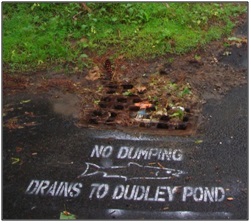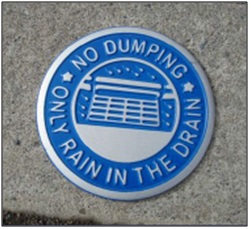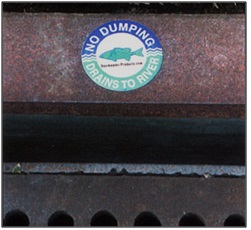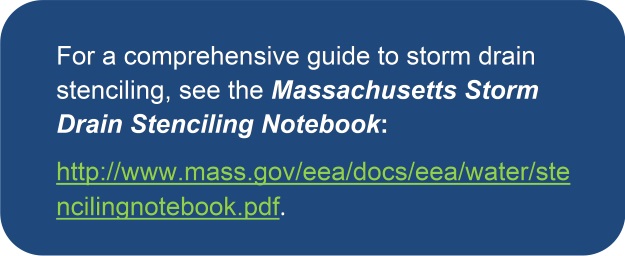Storm Drain Marking

Description
Storm drain marking involves labeling storm drain inlets with plaques, tiles, painted or pre-cast messages warning citizens not to dump pollutants into the drain. The messages are generally a simple phrase or graphic to remind those passing by that the storm drains connect to local waterbodies and that dumping will pollute those waters
Some storm drain stencils specify the name of the waterbody that the inlet drains to. More general messages include: "No Dumping. Drains to Water Source," "Drains to River," and "You Dump It, You Drink It. No Waste Here." Pictures can also be used to convey the message, such as a fish or frog, or a graphic depiction of the flow path from drain to waterbody. Communities with a large Spanish-speaking population might wish to develop stencils in both English and Spanish, or use a graphic alone.

Applicability
Municipalities can undertake storm drain marking projects throughout the entire community, especially in areas with sensitive waters or where trash, nutrients, or biological oxygen demand (BOD) have been identified as high priority pollutants. However, regardless of the condition of the waterbody, these signs can raise awareness about the connection between storm drains and receiving waters and can help to deter littering, excess fertilizer use, dumping, and other practices that contribute to stormwater pollution. Municipalities should prioritize drains for marking because marking all drains within a municipality may be prohibitively expensive. The drains should be carefully selected to send the message to the maximum number of citizens (for example, in areas of high pedestrian traffic) and to target drains leading to waterbodies where illegal dumping has been identified as a source of pollution.

Implementation
Municipal crews or volunteers can affix or stencil messages on storm drains. Some municipalities feel that having their own crews do the work produces better results and eliminates liability and safe ty concerns. Stenciling projects are also frequently conducted by volunteer groups in cooperation with a municipality. In such an arrangement, volunteer groups provide the labor and the municipality provides supplies, safety equipment, and a map and/or directions to the drains to be marked. Using volunteers lowers costs and increases public awareness of storm water pollutants and their path to waterbodies. A municipality can establish a program to comprehensively address storm drain stenciling and recruit volunteer groups to help, or the municipality can facilitate volunteer groups that take the initiative to conduct a marking project.
Regardless of who initiates the stenciling project, the municipality should designate a person to take charge of the storm drain marking program. Many municipalities will designate a person from the public works or water quality department to coordinate marking projects by volunteer groups, but some might work with their communications department. Because these programs depend heavily on volunteer labor, organizers and coordinators should possess skills in recruiting, training, managing, and recognizing volunteers. Organizers and coordinators should provide the following:
- Marking kits containing all materials and tools needed to carry out a marking project,
- A map of the storm drains to be marked,
- Training for volunteers on safety procedures and on the technique for using stencils or affixing signs,
- Safety equipment (traffic cones, safety vests, masks/goggles for spray paint, and gloves if glue is used), and
- Incentives and rewards for volunteers (e.g. badges, T-shirts, certificates).
It is also recommended that the coordinator provide pollutant-tracking forms to participants, so that serious instances of dumping may be recorded. Participants in storm drain marking projects can also note storm drains that are clogged with debris. This tracking system enables city crews to target cleanup efforts. Organizers should instruct volunteers on the signs of dumping and explain how to fill out data cards. In addition, volunteers should record the locations of all storm drains labeled during the project for the city to track. Additionally, the participants should convene after the event to discuss their findings. Participant feedback can help organizers improve future marking projects.
If a municipality chooses to initiate a storm drain stenciling program and solicit the help of volunteer organizations, they can advertise through a variety of channels. Outreach strategies include:
- Creating a web site with background and contact information
- Social media postings (e.g., Facebook, Twitter)
- Local newspaper ads
- Distributing pamphlets and brochures to area service organizations
- Making presentations at community meetings
Contact newspapers to provide advanced notice of a planned storm drain marking event. Newspapers might choose to cover the event itself as an environmental feature story to further public awareness. A news release issued for the day of the event can draw television and newspaper coverage. Public service announcements made before the event also will help to reinforce the message. Additionally, in targeted neighborhoods, volunteers can distribute door hangers that notify residents that storm drain marking is taking place, explain the purpose of the project, and offer tips on how citizens can reduce urban runoff.
For any volunteer project to be successful, volunteers must feel they have done something worthwhile. Communities active in storm drain stenciling have developed a variety of ways to recognize volunteers, including
- Providing each participant with a certificate of appreciation and/or letter of thanks signed by the mayor
- Distributing logo items such as T-shirts, hats, badges, plastic water bottles, or other items to participants before or after the event
- Holding a picnic or small party after the event with refreshments donated by a local business
- Providing coupons for free food or merchandise donated by local businesses
- Taking pictures of stenciling teams in action to create a pictorial record of volunteers’ activity, and for posting to website and/or social media.
Materials
Permanent signs made from metal, ceramic, plastic, or other durable materials can be affixed with adhesive applied to the street or sidewalk surface. These markers last longer than stenciled messages and need only glue to affix them to storm drain inlets. Non-toxic, double stick adhesive pads are available from sign manufacturers as an alternative to glue, which may not be appropriate for use by children. While many stock sign designs are available, municipalities can develop or commission designs specific to the locality, including, for example, the name of the waterbody to which the inlet drains. These permanent signs can also be neater and easier to read from a distance. Tiles or plaques can be dislodged by pedestrian traffic if they are disturbed before the glue dries, so pedestrians should be excluded from areas where signs have been recently affixed.
Alternatively, communities can use stencils and paint to label their storm drains. Some communities stencil directly onto the curb, street, or sidewalk, while others first paint a white background and then stencil over it. The most commonly used stencils are made of Mylar, a flexible plastic material that can be cleaned and reused many times. However, stencils can also be made from cardboard, aluminum, or other material. Because painted stencils are not as durable as other types of markers, the message might need to be retouched or reapplied every few years.
Paint or ink can be sprayed on or applied by brush and roller. Spray paint is the quickest and probably the easiest to apply neatly. However, regions that do not meet federal air-quality standards should avoid using spray paints, since many contain air-polluting propellants. To prevent any materials from entering the storm drain, the use of "environmentally friendly" paints free of heavy metals and low in volatile organic compounds is recommended.
Storm drain messages can be placed flat against the sidewalk surface just above the storm drain inlet, while others are placed on the curb facing the street or on the street itself, either just upstream of the storm drain or on the street in front of the drain. However, messages placed on the street might wear out or dislodge sooner.
Another option is to retrofit or equip new developments with catch basins, grates, or inlet covers that are pre-cast with a stormwater education message. While this option is the most costly of the storm drain marking alternatives, it is also the most durable and requires the least amount of maintenance. It does not foster public participation, however, because the messages require installation by professionals or city crews. Westchester County, New York, and the City of White Plains have begun installing the "Eco Curb" catch basins cast with location-specific messages on county and city roads (Westchester County Department of Planning, 2001).
Effectiveness
By raising public awareness of urban runoff, storm drain marking programs should discourage practices that generate stormwater pollutants. As with any public education project, however, it is difficult to precisely measure the effect that storm drain marking programs have on human behavior. Surveys of public recognition of the storm drain message, or surveys that capture changes in behavior, can indicate whether a storm drain marking program is effective.
Urban runoff, by definition, is diffuse in origin, making it difficult to directly measure the reduction of pollutants found in urban runoff. Some municipalities attempt to assess the effectiveness of storm drain marking programs by periodically examining water samples from targeted storm drain outfalls (places where storm drains empty into a waterbody). If the storm drains leading to a particular outfall have been labeled, and if the levels of pollutants from that outfall decline after the labels were put in place, one can assume the labeling has been effective. This monitoring can be conducted by the same volunteer groups that marked the drains and can be incorporated into existing volunteer monitoring programs or can initiate the development of a new program.
Cities also infer storm drain marking program success from increases in the volume of used motor oil delivered to used-oil recycling centers. Others measure success by how many drains are marked and the number of requests received by volunteer groups to participate in the program. The number of cleanups conducted by the city as a result of reports made by volunteers can also be considered.
Costs
Plastic stencils, which can last for 25 to 500 stencilings, depending on whether paint is sprayed or applied with a brush or roller, can be purchased for $13-$20 depending on the size, materials, quantity purchased, and manufacturer. Metal stencils, which last longer, can cost $100 or more.
Storm drain markers vary in cost depending on materials, design requirements, and the quantity purchased. Custom sizes, shapes, and designs, such as those that specify a local waterbody, can increase the unit cost. For stock messages, plastic markers of 4-inch diameter range in cost from $2.50 and $6.00. Metal markers, typically available in aluminum, stainless steel, and brass, range from $5.00 to $10.00 depending on the type of metal and mounting method.
References
Center for Marine Conservation.
How to Develop a Storm Drain Stenciling Program and Conduct Projects. 1998. Million Points of Blight.
Texas Natural Resource Conservation Commission. No date.
Storm Drain Stenciling: Preventing Water Pollution.
